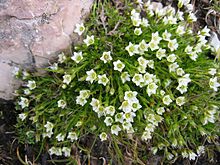| Minuartia | |
|---|---|

| |
| Minuartia gerardii | |
| Scientific classification | |
| Kingdom: | Plantae |
| Clade: | Tracheophytes |
| Clade: | Angiosperms |
| Clade: | Eudicots |
| Order: | Caryophyllales |
| Family: | Caryophyllaceae |
| Genus: | Minuartia Loefl. (1753) |
| Type species | |
| Minuartia dichotoma L.
| |
| Species[1] | |
|
67; see text | |
| Synonyms[1] | |
Minuartia is a genus of flowering plants commonly known as sandworts in the family Caryophyllaceae.
Minuartias are small annual or perennial plants which grow in otherwise inhospitable conditions such as on rocky ledges and in stony soil. Species are distributed in Eurasia and parts of Africa, including Europe, the Mediterranean region, northern and eastern Africa, the Caucasus, western and central Asia, Japan, and Far Eastern Russia.[2][1]
Many Minuartia species were formerly classed in the genus Arenaria, and the obsolete genus Alsine. In 2014, the polyphyletic Minuartia sensu lato was recircumscribed, with many of the species transferred to other genera, including Cherleria, Eremogone, Facchinia, Mcneillia, Minuartiella, Mononeuria, Pseudocherleria, Rhodalsine, Sabulina, and Triplateia.[2] Minuartia sensu stricto is characterized by the following features: leaves linear-setaceous; 5 acute sepals with 3, 5, or 9-veins; 5 white petals; 3 styles, forming 3-parted capsules.[2]
The genus was named for Juan Minuart (1693–1768), a Spanish botanist and pharmacist.[3]
- ^ a b c "Minuartia Loefl". Plants of the World Online. Royal Botanical Gardens Kew. Retrieved 24 March 2024.
- ^ a b c Dillenberger, Markus S.; Kadereit, Joachim W. (1 February 2014). "Maximum polyphyly: Multiple origins and delimitation with plesiomorphic characters require a new circumscription of (Caryophyllaceae)". Taxon. 63 (1): 64–88. doi:10.12705/631.5.
- ^ Wilhelm, Gerould; Rericha, Laura (2017). Flora of the Chicago Region: A Floristic and Ecological Synthesis. Indiana Academy of Sciences.